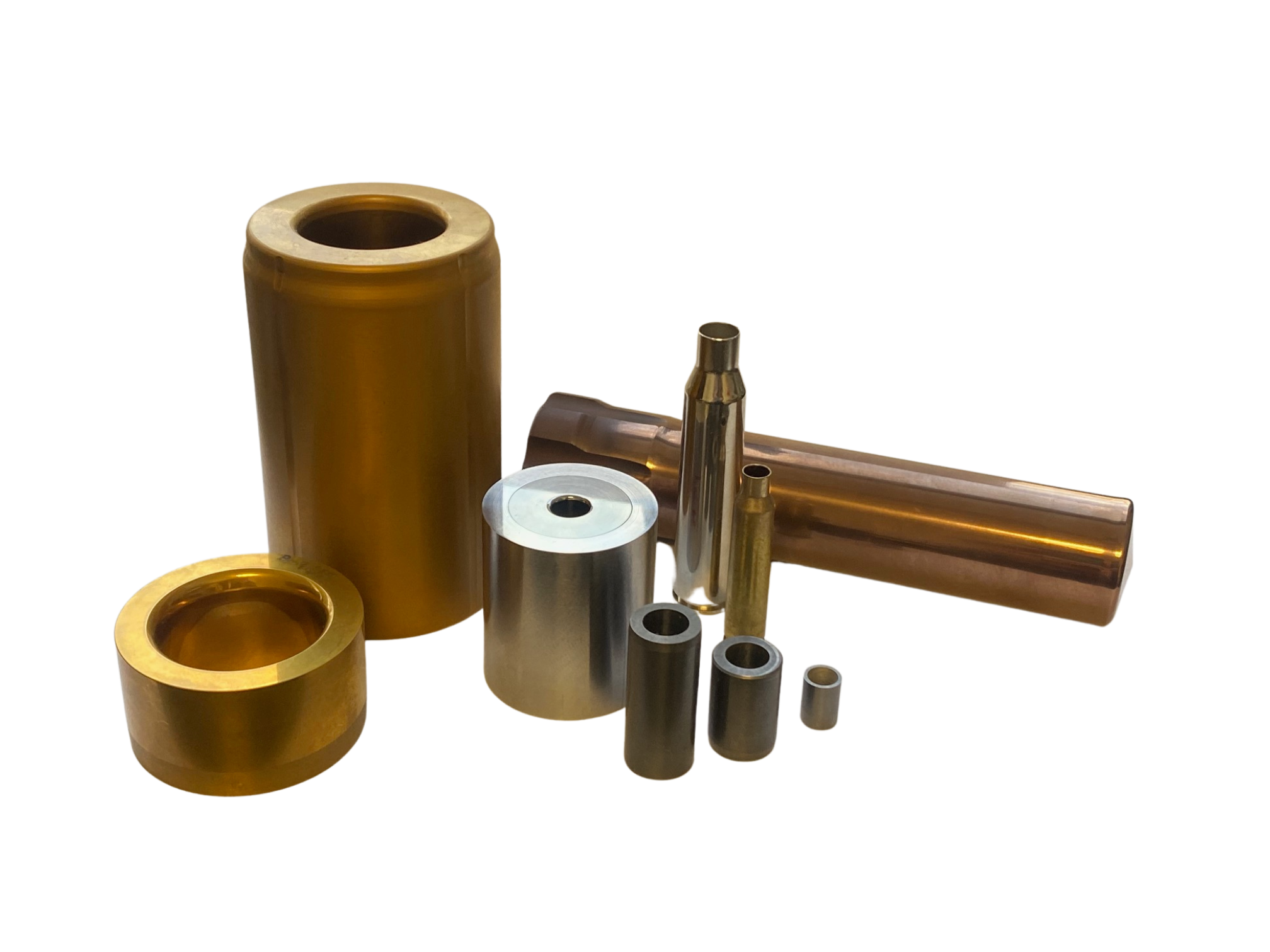
Tungsten carbide die bullets are changing how modern ammunition is made and used. Due to their extreme hardness and high density, these bullets can pierce tough materials more effectively than traditional lead or steel rounds. They’re designed to stay strong on impact, making them useful in defense and specialized shooting situations.
Tungsten armor-piercing bullets are often used in military settings because they can penetrate armor and other heavy-duty barriers. Their ability to stay intact and travel through hard surfaces makes them reliable in high-stakes environments.
However, using tungsten weapons comes with challenges. They cost more to produce, require more advanced manufacturing methods, and rely on a limited supply of raw materials. In this blog, we’ll explore how tungsten carbide bullet technology works, where it excels, and why it’s gaining interest, despite the trade-offs.
What Makes Tungsten Carbide Bullets Unique?
The tungsten carbide bullet stands out for two key reasons: extreme hardness and high density. Tungsten carbide dies are nearly as hard as diamonds, which helps bullets resist deformation on impact. It’s also almost twice as dense as steel, giving it more momentum and better penetration against tough targets.
How Tungsten Compares to Traditional Materials
When compared to standard lead or steel-core ammo, tungsten weapons offer major performance upgrades:
Armor-Piercing Capability
Tungsten armor-piercing bullets can penetrate much deeper than steel-core rounds. With a density of 15.6 g/cm³ (compared to steel’s 7.8 g/cm³), these bullets retain more energy on impact.
Tests on rolled homogeneous armor (RHA) show that tungsten carbide bullets can penetrate 20–30% deeper than steel at the same speed. That makes them especially effective against armored vehicles and reinforced structures where standard rounds might fail.
Heat Resistance
Tungsten carbide can handle extreme heat, with a melting point of 2,870°C. That means tungsten weapons can be fired at high speeds without losing shape, unlike lead or copper bullets that may soften or melt. This heat resistance is ideal for:
- Machine guns with rapid, sustained fire
- Aircraft cannons exposed to friction heat
- Sniper rounds that need consistent performance over long distances
Barrel Longevity
Depleted uranium (DU) rounds also pierce armor well, but wear out gun barrels faster. DU produces abrasive residue, while tungsten carbide stays stable and clean. As a result:
- Tungsten causes up to 50% less barrel wear than DU
- Less cleaning is required
- Precision barrels last longer
This is a big benefit for units that rely on accuracy over time, like designated marksmen or armored vehicle crews.
Note: Because of its hardness (9–9.5 on the Mohs scale), tungsten requires tougher tools during manufacturing. However, the long-term performance easily outweighs that extra cost.
How Tungsten Carbide Die Bullets are Made
Creating a tungsten carbide bullet involves a high-precision process that starts at the microscopic level. It begins with ultra-fine tungsten powder—usually between 1 and 10 microns—combined with a cobalt binder (around 5–15%). This mixture is carefully balanced to ensure strength and controlled fracture behavior, which is critical for penetration.
Step 1: Powder Preparation
The powder mix goes through:
- Spray drying to form consistent granules
- Quality checks for even particle distribution
- Moisture control to avoid cracks or voids during later stages
This preparation stage helps the material maintain both its extreme hardness and its ability to fracture in a controlled way, which is ideal for tungsten armor-piercing bullets.
Step 2: Precision Compaction
The dried granules are compacted into bullet-shaped forms using specialized carbide dies at over 50,000 psi of pressure. This high-pressure process offers several benefits:
- Excellent wear resistance (carbide dies last 10x longer than steel ones)
- Consistent shape with tight tolerances (±0.001 inches)
- Smooth surface finishes, reducing the need for extra processing
These durable dies can produce over 500,000 bullet cores before needing replacement, which is a big plus in a large-scale production of tungsten weapons.
Step 3: High-Temperature Sintering
The compacted parts—called “green bodies”—are sintered in vacuum furnaces at temperatures between 1,400°C and 1,600°C. This step:
- Removes binders
- Bonds tungsten particles together
- Shrinks the parts by about 15–20% with precise size control
The final core reaches 95–98% of theoretical density and achieves Vickers hardness levels between 1400 and 1600 HV, giving tungsten carbide bullets their well-known armor-piercing capabilities.
Step 4: Finishing and Quality Control
After sintering, each bullet goes through:
- CNC grinding for exact dimensions
- Polishing to reduce friction inside the barrel
- Optional copper or nickel plating for corrosion resistance
Every bullet is inspected using non-destructive testing methods like X-ray and ultrasound to ensure there are no internal flaws.
Once complete, these advanced projectiles are ready for their main role in defense, where their precision, durability, and strength give tungsten armor-piercing bullets a serious edge in the field.
Military & Defense Applications
The durability and performance of tungsten carbide die bullets make them a strong fit for military use, especially in situations where traditional ammo doesn’t measure up. Their hardness, density, and heat resistance allow them to meet the demands of modern defense systems across air, land, and sea.
Anti-Armor and Anti-Vehicle Use
Tungsten armor-piercing bullets are highly effective against armored vehicles like personnel carriers and light tanks. Thanks to their strength and stability, they can:
- Penetrate armor up to 50% thicker than what steel-core rounds can handle
- Stay intact after impact, which lowers the risk of ricochet
- Deliver consistent performance in extreme conditions—from desert heat to freezing cold
These rounds are often used in squad automatic weapons (SAWs) and vehicle-mounted machine guns to stop threats that standard bullets can’t handle.
Precision Shooting and Anti-Materiel Use
Tungsten weapons are also valuable in long-range precision roles. Sniper rifles allow for flatter trajectories and more reliable accuracy at distances over 1,500 meters. These bullets are also used in:
- Anti-materiel rifles to disable engines, equipment, and light structures
- Designated marksman rifles that need to shoot accurately through barriers
A good example is the U.S. military’s Mk 211 Mod 0 API round, which combines tungsten carbide bullet technology with incendiary effects to serve multiple functions in combat.
Aircraft and Naval Applications
Air forces use tungsten armor-piercing bullets in 20mm to 30mm autocannons for air-to-ground attacks and strafing missions. These rounds also show up in:
- Helicopter-mounted guns that need to punch through cover
- CIWS (Close-In Weapon Systems) on ships for last-resort missile defense
Naval variants are often coated to resist corrosion caused by saltwater environments.
Emerging Counter-Drone Systems
As drones become more common in warfare, so does the use of tungsten weapons to stop them. These bullets are now used in:
- Mobile anti-drone launchers
- Automated sentry guns
- High-speed intercept systems
Because they’re heavier than standard rounds, tungsten carbide bullets improve hit probability against fast, small targets like UAVs.
Challenges and Limitations
While tungsten carbide bullets offer outstanding performance in the field, they come with trade-offs that limit their widespread use. From high production costs to supply chain issues, here are the main challenges that come with this advanced technology:
High Production Costs
Manufacturing tungsten armor-piercing bullets is far more expensive than making traditional rounds. The cost drivers include:
- Raw materials – Tungsten carbide powder is much more expensive than lead or steel
- Energy usage – Sintering the material requires extremely high temperatures and lots of power
- Specialized tooling – Precision dies and CNC machining raise the cost per bullet
In most cases, these rounds cost 3 to 5 times more than standard steel-core ammo, making them harder to afford for large-scale use.
Heavier Weight
The density that gives tungsten weapons their power also makes them heavier. This can lead to:
- Reduced magazine capacity – Fewer rounds per loadout
- Increased recoil – Harder to control in rapid fire
- Wear and tear – May require reinforced weapon components
For example, a 7.62mm tungsten carbide bullet can weigh up to 30% more than a lead-core round, affecting both soldiers and their equipment.
Brittleness Under Stress
Tungsten carbide is extremely hard but also brittle under certain conditions:
- It may shatter when hitting angled or composite armor
- It’s less effective against reactive or spaced armor setups
- It fragments less than depleted uranium, reducing soft-target damage
These limitations can reduce the overall effectiveness of tungsten armor-piercing bullets in complex combat scenarios.
Supply and Environmental Issues
Tungsten is not easy to source or process:
- Global supply is limited, with China controlling about 80% of tungsten mining
- Environmental regulations make mining and refining more difficult in other regions
- Recycling tungsten from spent rounds is possible but not always cost-effective
These factors create supply chain risks for militaries that rely heavily on tungsten weapons.
In short, tungsten carbide bullets are powerful tools with specific advantages, but their high cost, weight, and material challenges prevent them from fully replacing conventional ammo. Still, ongoing research and innovation may help reduce these limitations and expand their role in future defense systems.
The Future of Tungsten Carbide Ammunition
Tungsten carbide bullets are evolving beyond traditional armor-piercing roles. New innovations—like composite materials to reduce brittleness and 3D printing for complex shapes—are improving both performance and design.
The range of applications is also growing. Today’s tungsten weapons are being used for counter-drone defense, law enforcement, and even eco-friendly training rounds. These developments make tungsten armor-piercing bullets more versatile across military, security, and commercial use.
As research continues, expect even better materials and production methods, making tungsten solutions more accessible and effective.
Partner with Us for Advanced Material Solutions
Our team works across the entire spectrum of tungsten carbide applications—from industrial tooling to high-performance ammunition components.
If you’re developing a tungsten carbide bullet or working on a project involving tungsten weapons, we can help. We offer:
- Custom formulations tailored to your exact performance needs
- High-end carbide dies built for long-term, precision use
- Expert guidance on materials and manufacturing processes
Whether you’re focused on defense, security, or industrial use, our experience ensures you get the right solution for your application.
Reach out today to talk with our team about your project. Let’s create something built to perform.



